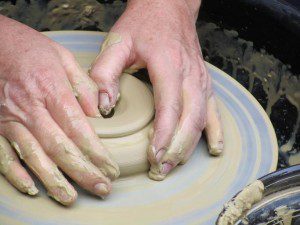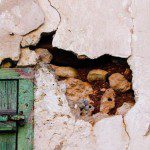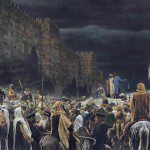
Centering always comes first
After wedging the clay, that is,
And thumping it down on the wheelhead
And sponging it slippery slimy wet
Hands close over the leftward spinning earthen mound . . .
(From “Utterance” by Jane Fremon)
I’ve been thinking again lately of pottery. I’d like to make some. It’s on my list of “things to do before I die,” where I harbor hopes for various postponed pleasures, clinging to Chesterton’s assurance that “If a thing’s worth doing, it’s worth doing badly.” And I would, I imagine, do it badly. But the experience would be worth having. As in so many kinds of creative work, “Centering comes first.” And after the centering, the work, the witnessing, and the discovery. Potters and sculptors often speak of “finding” the figure in the clay or stone. Writers also occasionally share that experience, “finding” a poem in a field of wild words. Centering prepares you for seeing.
I recently met with one of the priests from our local Episcopal parish—a lovely man, who was a judge before he entered the priesthood, and now, claiming another dimension of a life richly lived, spends his free hours at a potter’s wheel. Many bowls and mugs into his journey with clay, he speaks with visible, stirring pleasure about the feel of it–the discipline, and the freedom. He had heard from my husband about my recurrent wish to be a person who pots, and as we sat down to talk, as I supposed, of more church-related things, he began, “I hear you need to make a bowl.”
I do. I know exactly what it is to look like. In my mind’s eye it is deep enough to fill with water up to the wrist, and wide enough to provide a hospitable space for grain or pasta or apples. And it is glazed in sky-tones—light and dark blues and slate grey. It is solid and stable at the bottom, but tapered at the outer edges to the thinness of an oboe’s reed. When I make it, one day before I die, it may be crooked; it may end up as a small desk-top container for paper clips, or a coaster. But I hope for a bowl.
Potters, like gardeners, find their healing and learning and song when they touch earth. “Earth’s the right place for love,” Robert Frost wrote in “Birches.” And another poet laureate, Richard Wilbur echoes his insight in a poem he entitled “Love Calls us to the Things of This World.” In one line of that poem he celebrates “the world’s hunks and colors.” And its words, its water, the clay the sun warms. Karen Fiser, another favorite poet, wrote a poem about a sculptor called “Loving the Clay.” Asked how she decided to become a sculptor, the 88-year-old woman’s answer is that “she’d never had any /mission in life, she’d just loved the clay.” There is, as it turns out, a lot of poetry about pottery. It seems to be a craft that takes its practitioners to a place where earth and heaven meet.
In a season of the liturgical year that calls us to humility, it is good to remember that the word’s root is humus–the soil from which we are made. Humus is the organic matter that holds nutrients necessary for life and growth. We remember that we are dust in this season, and also how dust becomes clay and how clay, yielding to skilled and loving hands, may become, to borrow Mother Teresa’s phrase, “something beautiful for God.” “We are the clay, and you are our potter,” Isaiah says simply, adding “we are all the work of your hand.” The metaphor has made its way into hymns and homilies for centuries, reminding us that we belong to God, and each other, and the earth, molded and given breath and called to the things of this world for a while, fitted for this journey with five senses to serve us while we’re here. What we learn from them may prepare us in ways we can’t imagine for what is to come.












